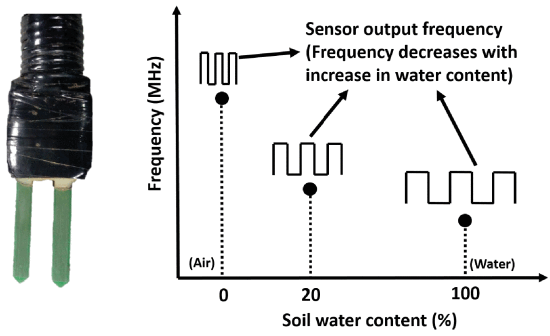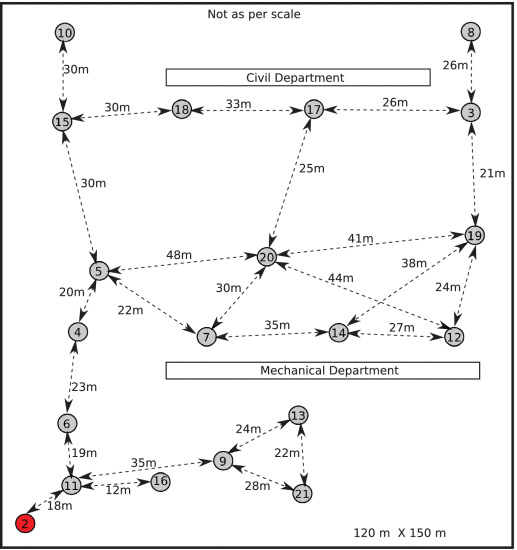IoT in Agriculture
Multi-hop wireless sensor network for in-situ agricultural applications
25 May 2021 | Special thanks to Karan P. Rane. Research paper by Jobish John, Vinay S Palaparathy, Gaurav S Kasbekar and Maryam Shojaei Baghini. Edited by Pratyush Ragini
Aridity is an ecological situation in which water income is less than potential water expenditure (runoff, evapotranspiration, etc.). 48% of India’s landmass is either arid or semi-arid. With life on the farm becoming more and more uncertain, it is important to measure and analyze whatever we can. This would allow for a system to control the water input more optimally. Metrics like soil moisture content and nitrogen content need to be kept track of more accurately. Through their research, Jobish John et al, are looking at qualitatively and quantitatively better ways to monitor farm conditions. The primary focus is also on optimising the cost factor, which is a significant hurdle to India’s financially challenged farm sector. They have designed and implemented a wireless sensor network (WSN) for agricultural monitoring application using multi-hop tree-based architecture. The sensor network has two functions: sensing soil moisture and transmitting the sensed information wirelessly to a central node.

Neutron scattering probe technique, time-domain reflectometry (TDR), frequency domain reflectometry (FDR), and microelectromechanical systems (MEMS) are some technologies that are usually used for in-situ soil moisture measurement. However, these techniques are expensive, so the researchers developed in-house capacitive-based soil moisture sensors. For these sensors, the soil acts as the dielectric medium. When the water content in this soil varies, there is a change in the dielectric constant of the medium and consequently a change in the capacitance. This is then calibrated and used to measure the change in soil moisture. This technique also holds the advantage of quick response time and lower power consumption.
ZigBee and LoRa are generally preferred wireless technologies for agricultural applications because of their low power consumption and wide communication range. But these are expensive and not easy to use. Hence the researchers have used TelosB modules for wireless communication at the nodes in the multi-hop wireless network architecture.
The nodes of the sensor network are deployed in a random fashion on an agricultural farm. Each node senses information and sends it to a central node called the sink node which is connected to a base station where decisions are made based on the analysis of the collected data. A cycle of data transmission starts with the formation of a data collection tree followed by the synchronised periodic sleep-wake up scheduling of the nodes.
A data collection tree is a map which the central node generates after receiving connectivity information of all the nodes. The gathering of information starts with the neighbour discovery phase. Each node finds all its neighbouring nodes and assigns a weight to each of them. The weight between two nodes is computed using the node’s battery levels and the quality of the wireless link connecting the nodes. The data collection tree can be constructed using algorithms such as minimum spanning tree and the shortest path tree. The researchers have used the latter for its efficiency. Once the data collection tree is built, the sink node informs each node about its parent, and all the nodes are synchronised to the sink node along the edges of the tree using a modified version of the flooding time synchronisation protocol (FTSP). Time synchronisation helps the nodes follow a coordinated periodic sleep wake-up schedule to save energy and increase the node’s lifetime.
The researchers implemented a WSN consisting of 20 sensor nodes in the IIT Bombay campus. The sensor nodes were placed randomly in a region covering approximately 120 m × 150 m. The region lies between the Department of Civil Engineering and the Department of Mechanical Engineering and holds red soil. The sink node was connected to a laptop, which was used as a base station for logging the sensor data. Each sensor node was equipped with an in-house developed capacitive soil moisture sensor, an atmospheric temperature sensor, and a relative humidity sensor. A Lithium-ion battery was used- to power the system, and store the energy produced by the solar panel accompanying the system. The soil moisture sensor was deployed at a depth of 10 cm from the surface. MCP9700A and HIH5030 were used to measure the atmospheric temperature and relative humidity, respectively. Each node was equipped with a TelosB mote which uses an IEEE 802.15.4 compliant radio chip CC2420 for wireless communication.

The interval between two consecutive data collection time slots in the experiment was 1 hour, and the data collection tree was rebuilt once every 10 hours. In actual field applications, the same data collection tree can be used to collect the sensor readings for a longer period so that the energy overhead because of the tree construction phase can be minimised. The researchers used TDR (TRIME PICO 64) to validate the measurements obtained from the capacitive sensors. This work can also be translated to other developing nations with a similarly resource-challenged agriculture sector.
With crop loss across the country becoming a challenging issue, it is imperative to make use of technology like IoT to make the best use of the land and resources we have. Measuring soil moisture content could provide vital irrigation data to the farmer to improve yield. To take this idea a step further, Proximal Soilsens, incubated by Society For Innovation & Entrepreneurship (SINE), IIT Bombay, is conducting pilot tests in agricultural fields across the country and is looking to scale up implementation.